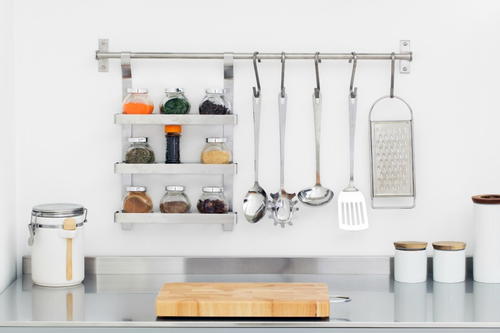How to Master Once a Month Cooking (and Save a Ton)

I’m Marie from Underground Crafter and today I want to talk about a solution for those of you who want to eat homemade food every day but don’t always have the time to cook.
Once a month cooking (also known as OAMC, make-ahead meals, or freezer cooking) is a great option if you don’t often have time to prepare meals, or if you want to have meals on hand for your family when you’re traveling or working late.
The idea behind once a month cooking is that you put aside a large chunk of time (usually, about a day) once a month to prepare meals (or components of meals) for the rest of the month. These meals are then frozen and defrosted throughout the month on an “as needed” basis.
Once a month cooking is also a great way to save money, since you can buy ingredients in bulk at lower prices or spread expensive ingredients over many meals before they spoil.
And, if you live in a household where one person has different dietary needs from everyone else, you can more easily get these singleton meals ready.
If once a month cooking sounds right for you, here are five tips to get you started on your OAMC journey.
Choose your approach
There are three main approaches to once a month cooking.
- You can prepare entire meals to freeze in portioned containers. If you live alone or your household has many different eating preferences, use individual meal portion containers. If you live in a household where everyone eats the same meal, use family-sized containers.
- You can prepare batches of protein or vegetables that can be used to save time on meal prep throughout the month. For example, prepare a large roast and then shred or dice it up. After defrosting, add it to a quick pasta sauce, tacos, or another 30 minute meal.
- You can prepare large recipes for baked goods and freeze individual portions. Many of these recipes (like drop cookies or dinner rolls) can be frozen raw and go directly from freezer to oven with good results. Others (like quick breads or baguettes) can be baked, sliced, and then frozen in individual portions.
Get organized
Once you know your approach, you’ll need to be sure you have enough containers for your meals. Be sure to use freezer-safe containers, like plastic and glass or freezer-safe bags. Depending on your approach, you may need to stock up on different sizes. For example, if you are portioning for an individual, you’ll need many containers in smaller sizes, whereas for family-sized portions, you’ll need fewer but larger containers.
It helps to have different types of containers with different shapes and lid colors to help you identify meals at a quick glance.
Choose a tracking system to help you find and use the food in a timely basis. (According to the USDA, foods can be safely stored in the freezer indefinitely, but after three months, you will notice a loss in flavor quality.) Note the meal, container type, and “eat by” date on a magnetic notepad on the refrigerator, on a bulletin or dry erase board in the kitchen, or in an app. If you have more than one freezer, be sure to note the location where you stored the food!

Find your recipes and buy your ingredients
As you prepare for your first once a month cooking session, look for recipes that meet your preferences and have larger portion sizes. Soups and stews freeze particularly well, as do most slow cooker meals. Prepare a shopping list and set aside the time for cooking.
Start cooking!
On the day of your first once a month cooking marathon, clear your counter space and set up a schedule to maximize oven and stovetop space. Do your prep for as many meals as possible by cutting up seasonings and herbs and other common ingredients. Try to clean up and put away ingredients, pots, pans, and tools as you finish using them.
While you will probably have a flurry of activity at the beginning during prep and at the end as you pack your foods for freezing, you may find that most of the day is pretty boring. If you step out of the kitchen, be sure to set up timers or check in regularly to avoid burning or overcooking your food.
As you finish each item, distribute into your freezing containers. Make notes in your tracking system.
Understand safe defrosting
Now that you’ll be eating more home cooked meals from the freezer, it helps to understand the ways of safely defrosting food to avoid spoilage and bacteria growth. The USDA recommends four methods for safely thawing food: refrigerator thawing, cold water thawing, microwave thawing, and cooking without thawing.
Recipes for Once a Month Cooking
Ultimate Cowboy Casserole
1930s Kitchen Sink Casserole
Dump and Go Amish Casserole
Fully Loaded Chicken and Potato Bake
Have you tried once a month cooking?

